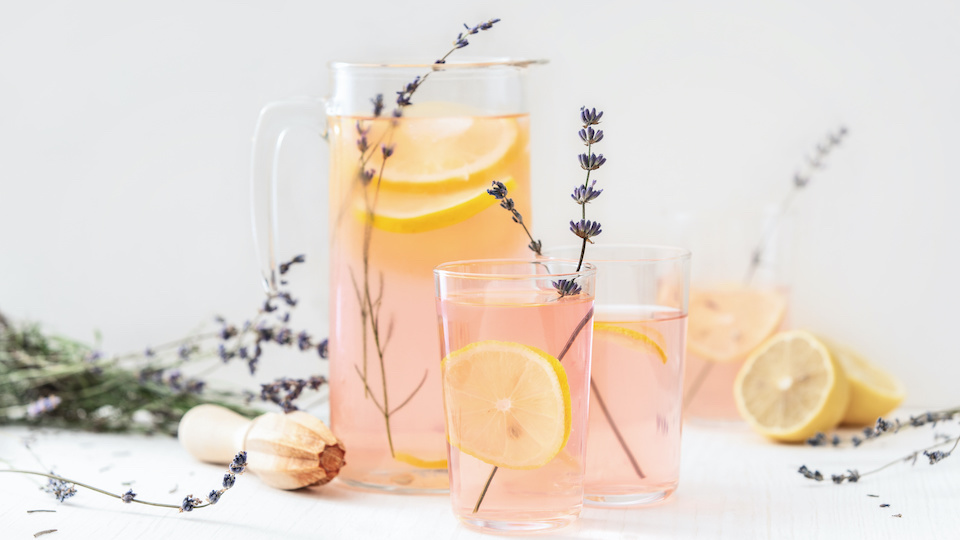Who doesn’t love an ice-cold glass of lemonade on a hot summer day? What is even better than a glass of lemonade is a glass of homemade lemonade made with plants from your very own lemonade garden. You won’t believe how incredibly easy it is to create and care for your own lemonade garden. Here’s how to do it.
Plants to grow in your lemonade garden
The plant recipe for a delicious lemonade garden includes:
Sunshine Blue Dwarf Blueberries
- Planting: Plant small transplants directly into the garden in a hole twice the size of the root ball. Plant in early spring as soon as the ground can be worked. Hardy in zones 5-10. 1 per sq. ft.
- Harvest: Harvest berries when they reach desired ripeness.
- Tips: After the first year, prune branches in early spring before blossoms develop.
- Consider this: Brown leaves could be a sign of too little water. Make sure to keep your blueberry bush hydrated.
Stevia
- Planting: Perennial in planting zone 9 and warmer. Transplant small plants into the garden after all danger of frost has passed. 1 plant per sq. ft.
- Harvest: Harvest in midsummer before plants bloom and dry. Or use fresh throughout the growing season.
- Tips: Pinch or trim back the plant often to encourage bushiness and prevent premature flowering.
- Consider this: Stevia is sensitive to soggy soil so make sure not to overwater.
Pineapple Sage
- Planting: Perennial in zones 8-11. Transplant starter plants in spring one to two weeks before last frost. 1 plant per sq. ft.
- Harvest: Enjoy harvesting leaves and flowers as needed throughout the growing season.
- Tips: Northern zones can dig up pineapple sage in the winter and bring indoors or provide other protection such as mulch to help it survive the cold season.
- Consider this: Hummingbirds and butterflies love the vibrant flowers. Enjoy watching beautiful wildlife enjoy your plant.
Lemon Balm
- Planting: Lemon balm does best when grown from small plants. Transplant into the garden after all danger of frost has passed. 1 plant per sq. ft.
- Harvest: Harvest sprigs as needed throughout the growing season.
- Tips: Though lemon balm does not spread by underground runners like mint, it will still spread seeds and begin to take over the garden if left unchecked. Trim it back to several inches tall a few times during the growing season.
- Consider this: Trim back most of the lemon balm any time it is beginning to look tired or leggy. Don’t worry! It will grow back fuller and healthier than ever in no time.
Alpine Strawberries
- Planting: Transplant small plants into garden a few weeks before the last frost date. 1 plant per sq. ft.
- Harvest: Berries will be ready to harvest around 30 days after the flowers bloom. Fruit should be bright red and firm.
- Tips: Birds absolutely love strawberries. Protect your plants with lightweight bird netting as the berries ripen.
- Consider this: Don’t bury the crown of the strawberry plant as leaves and fruit develop there. Just plant the roots and keep the crown level with the soil surface.
English Lavender
- Planting: Lavender does best when grown from small plants. Transplant into the garden after the last frost when temperature stays above 40 degrees F. 1 plant per sq. ft.
- Harvest: Harvest sprigs as needed throughout the growing season.
- Tips: Harvest with garden shears to preserve fragile blooms and maximize flavor. Harvest in the early morning when oils are most potent, and the flavor is strong.
- Consider this: Lavender can develop fungus if climate is humid. Trim plants to provide air circulation. Prune back lavender each spring, leaving about ⅓ of old-growth.
Make your very own delicious lemonade
Now that you have your garden in full swing, try this delicious homemade lemonade recipe. It is sure to wow!
Blueberry Lemon Twist
Ingredients:
- 3 cups fresh blueberries
- 1/3 cup honey
- 1 cup freshly squeezed lemon juice
- 5-6 cups water, divided
- Blueberries and lemon slices for garnish
Instructions:
- Add one cup water to a small saucepan over medium heat and bring to boil. Whisk in honey until completely dissolved. Remove from heat and allow to cool.
- Add lemon juice, 1 cup water, and blueberries to a blender and blend until totally smooth.
- Strain through a fine sieve or cheesecloth to remove any chunks.
- Stir in honey mixture and the remaining 3 cups of water.
- Chill and serve over ice.
-Susan Patterson



